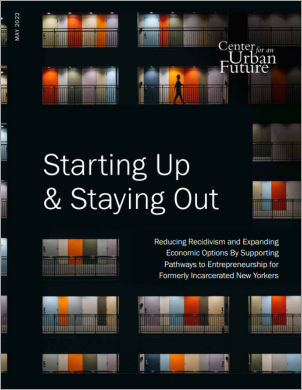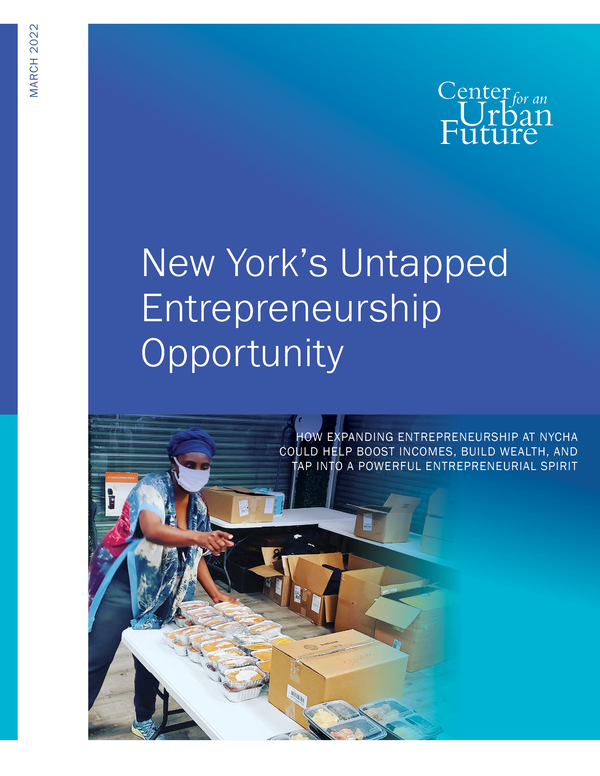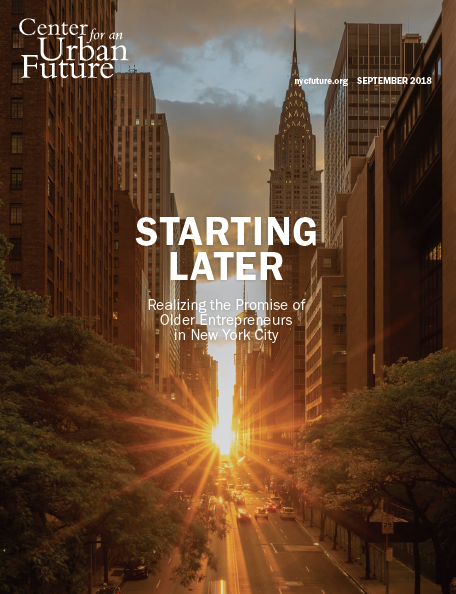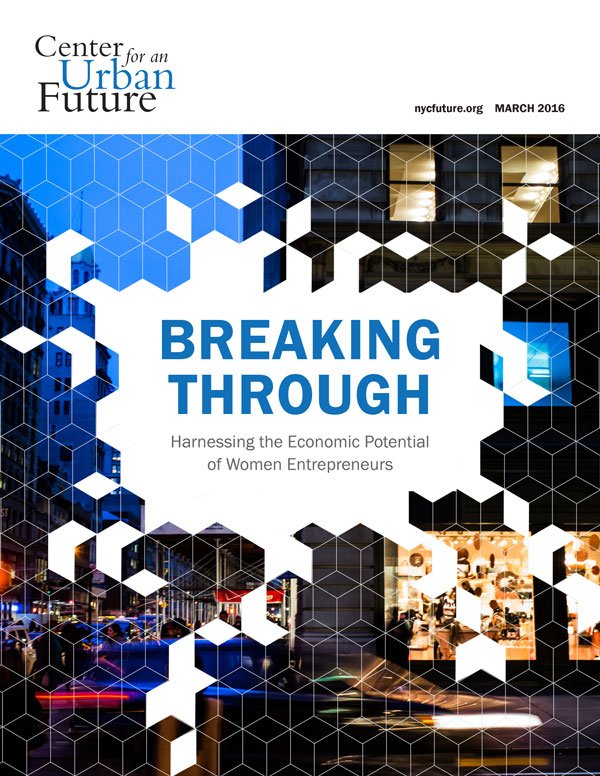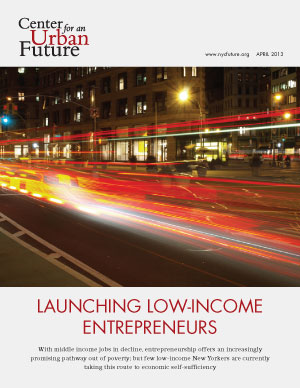Few New Yorkers face a tougher road to stable employment today than those returning from a period of incarceration. Indeed, the unemployment rate among people who have been to prison is almost five times higher than among the general population. In New York City, the current rate is hovering near 7 percent, which means that an estimated 35 percent or more of the city’s formerly incarcerated residents are likely unemployed.1
Given these long odds, formerly incarcerated New Yorkers are searching for other ways to generate income— and entrepreneurship provides a meaningful pathway with significant room to grow. Strengthening support for reentry entrepreneurship offers policymakers one vital, yet largely untapped, opportunity to help far more returning New Yorkers succeed in reentry and beyond.
An entrepreneurial spirit already runs through the city’s formerly incarcerated population. Our research shows that up to 40 percent of returning New Yorkers participating in reentry programs are interested in entrepreneurship and self-employment—as many as 5,000 would-be entrepreneurs each year—but far fewer take the leap. For those who manage to vault the initial hurdles, the impact can be transformative. Formerly incarcerated entrepreneurs outearn formerly incarcerated people who never took part in entrepreneurship, even when they seek employment. They are also 33 percent less likely to reoffend.2
Despite the power of reentry entrepreneurship to create economic opportunity and reduce recidivism, major barriers remain. These challenges extend far beyond those facing other aspiring entrepreneurs, including probation and parole conditions that make it difficult to focus on entrepreneurship, unique barriers to accessing credit as a formerly incarcerated person, shockingly high costs for essentials such as business insurance, and an overwhelming likelihood of returning on the wrong side of the digital divide.
Given the scale of these challenges, the lack of support for reentry entrepreneurship at the city and state level is striking. Just two of 50 prisons across New York State offer classes in entrepreneurship. Although nine of 24 city-funded Alternative to Incarceration (ATI) programs offer job training or employment services, none offer support for entrepreneurship. And despite the unique challenges that aspiring reentry entrepreneurs face fewer than five programs operating in New York City are designed specifically to help people transitioning back to their communities launch their own ventures, none of which receives city or state funding for entrepreneurship training.
New York City is down hundreds of thousands of jobs from its pre-pandemic peak, making now an ideal moment for the city and state to help far more returning New Yorkers generate income through entrepreneurship. Even a relatively small investment in formerly incarcerated entrepreneurs could have a significant impact. City leaders should commit to providing 2,500 formerly incarcerated individuals with entrepreneurship training over the next five years, backed by a $2.5 million investment; launch the city’s first entrepreneurship training program tailored to formerly incarcerated New Yorkers; and work with the state to expand entrepreneurial education to every correctional facility in New York.
By strengthening this vital pathway for returning New Yorkers, Mayor Eric Adams and the New York City Council could both help reduce recidivism rates for the long term and spark wealth creation in communities disproportionately affected by the long shadow of incarceration.
Each year, approximately 10,000 New York City residents are released from state prisons and return home.3 For these formerly incarcerated New Yorkers, securing a reliable source of income is a crucial first step to successfully reentering their communities and preventing recidivism—yet almost half of all formerly incarcerated people have no reported earnings during the first year after release. New Yorkers returning home face daunting job prospects even in a strong economy; however, the lasting economic damage afflicted by the pandemic has hit communities with the highest rates of incarceration especially hard.
This report, made possible by a grant from JPMorgan Chase & Co., builds on the Center for an Urban Future (CUF)’s 25 years of research about the role of entrepreneurship in creating a more inclusive economy in New York City, including the 2013 study Launching Low-Income Entrepreneurs. This report investigates the current state of entrepreneurship among formerly incarcerated New Yorkers and what is needed to expand the number of successful new businesses launched by New York’s reentry population.
Informed by extensive data analysis and interviews with more than 40 experts in reentry, community justice, microfinance, small business development, and entrepreneurship training—including more than a dozen formerly incarcerated entrepreneurs—the study explores the opportunity to expand support for reentry entrepreneurship and ensure more of the formerly incarcerated New Yorkers who start businesses can succeed. It examines the current supports for still incarcerated aspiring entrepreneurs and for formerly incarcerated New Yorkers looking to start or grow their own business as they return to their communities. It also identifies the key obstacles preventing justice-involved New Yorkers from launching successful businesses, profiles best practices from other states, and advances ten concrete and achievable recommendations for how city and state policymakers, the business community, nonprofit leaders, and philanthropy can work together to expand reentry entrepreneurship and strengthen a vital pathway to economic opportunity for returning New Yorkers.
Supporting pathways to entrepreneurship for those leaving incarceration is critical to reducing recidivism and boosting long-term economic prospects—and current conditions increase the urgency to act.
Even during an economic boom, New Yorkers transitioning back into their communities after release from jail or prison face some of the toughest barriers to employment and even greater challenges accessing secure, well-paying jobs. Only 55 percent nationally report any earnings during the first 12 months following their release, and those who do earn just over $10,000 on average.4 A bachelor’s degree has become a prerequisite for the vast majority of middle-wage jobs, yet fully 41 percent of those incarcerated in New York State prisons do not have a high school diploma.5 In 2019, the fifteen neighborhoods with the highest imprisonment rates had an average unemployment rate of 8 percent—twice the citywide average—and median wage and salary income of less than $35,000 per year, more than $8,000 below the city average.6
For New Yorkers with a history of justice involvement, the pandemic created new challenges even for those who had been able to find work. “About 40 percent of our participants who were working lost their jobs during COVID,” says Jocelynne Rainey, former executive director of Getting Out and Staying Out (GOSO), a reentry organization based in East Harlem.
Because jobs are scarce in general and competition fierce for accessible jobs that pay a living wage, reentering New Yorkers often are forced to seek other ways of earning income. Many are looking to start their own business— and realize a dream they’ve harbored for years.
Stephen Jackson, former CEO of Workshop in Business Opportunities (WIBO), an organization that offers entrepreneurship training to reentry individuals and other members of underserved communities, says that formerly incarcerated people he works with “want freedom. They want to be their own boss. They want to control how their life goes. They want to provide for their family. They want to leave a legacy for their family and build generational wealth. You could pass on a business; it’s very, very, very difficult to attempt to pass on a job. There are so many options that you have when you own your destiny.”
Starting a business, though, is especially difficult for New Yorkers reentering their communities after a period of incarceration. Aspiring entrepreneurs are likely to have limited or no credit, little if anything in the way of savings, and a fractured social network after time spent away from home, among other major challenges. Many formerly incarcerated entrepreneurs could overcome these challenges with the right support in place. However, our research finds that the city’s infrastructure for encouraging and sustaining reentry entrepreneurship is sorely lacking.
Although New York City is home to a handful of organizations that provide entrepreneurship training specifically for formerly incarcerated people, there are not enough seats to meet the demand. Formal connections between reentry- and small business development–focused organizations are few, and formerly incarcerated people often do not know how to access such resources. Those interviewed for this report, both formerly incarcerated individuals and other experts, also say that the ideal time to offer entrepreneurship training is in prisons, but only two of the 50 New York State prisons—Walkill and Sing Sing Correctional Facilities—offer classes in starting a business, and both programs were partially on hold because of the pandemic. The Network for Teaching Entrepreneurship (NFTE) previously offered entrepreneurial education programs on Rikers Island, but the initiative ended in 2018. "I'd love to see it revived," says NFTE President & CEO J.D. LaRock.
In addition, although the research suggests that as many as half of all returning citizens in New York are interested in exploring entrepreneurship—roughly 5,000 people in an average year—reentry organizations with entrepreneurship programs have funding and support to offer just a few dozen slots each year.
This is a missed opportunity for New York City to support a highly sought-after pathway to economic opportunity.
The appetite for stronger entrepreneurial supports is clear to anyone who works with currently or formerly incarcerated New Yorkers. Fully one-third of all library research questions asked in prisons are variations of “How do I start my own business?” reports Diego Sandoval Hernandez, correctional services librarian at Brooklyn Public Library. “People want to make a livelihood and be independent in making that livelihood— to lead their own enterprises.” Jocelynne Rainey says that about 40 percent of participants in GOSO’s reentry programs want to start businesses. Formerly incarcerated entrepreneurs interviewed for this report estimate that as many as 30 to 50 percent of the people they knew behind bars were interested in entrepreneurship. However, given little to no access to training while incarcerated and far too few courses tailored to their needs available when they return to their communities, their chances to launch their own businesses—and realize the many benefits that come with entrepreneurship—are slim.
The pandemic-linked economic downturn may provide a unique opportunity to boost reentry entrepreneurship and plant the seeds of community wealth.
At first glance, the economic downturn due to the pandemic might seem an inopportune time to start a business. But interviews with reentry program providers and formerly incarcerated entrepreneurs reveal that the unique circumstances created by the pandemic present an important opportunity for the city to help justice-involved New Yorkers explore entrepreneurship.
Participants in GOSO’s reentry program “know that it’s hard out there [in the job market] for returning citizens and think that there’s more opportunity for them to move towards some wealth through entrepreneurship,” says Rainey. “They’re really trying to take their talents and their energies into the things that they love and turn those into businesses.” Many of the young men working with GOSO are starting fashion and music microenterprises during the pandemic, Rainey explains, in part because few living-wage opportunities are accessible to them.
Reentry entrepreneurship also has the potential to play a significant role in building wealth and opportunity within justice-impacted communities. Recognizing this, the Fortune Society and Columbia Business School launched an entrepreneurship training program in January 2021 for 19 formerly incarcerated clients. The idea was inspired in part by what Carolyn Githinji, formerly of the Fortune Society and now CEO at reentry training organization Refoundry, had seen during the 2008 recession, when she was assistant commissioner at the New York City Department of Small Business Services (SBS).
“One of the biggest things that came across was the need for people to have their own business. The majority of businesses I was working with were minority and women-owned, and because they hire their own, there will be a multiplier effect in their communities,” Githinji says. “So when COVID hit, accompanied by an economic crisis, the idea was ‘let’s see how we can work with returning citizens who can become entrepreneurs.’”
Reentry entrepreneurship boosts long-term income, reduces recidivism, and creates wealth and opportunity in disadvantaged communities.
The value of formerly incarcerated business ownership and self-employment extends far beyond realizing dreams of being your own boss. Those who are able to launch their own ventures are more likely to find economic success than their non-entrepreneur peers.
“Formerly incarcerated people who start businesses have a higher income than those that have employment,” says says Damon Phillips, former codirector of the Tamer Center for Social Enterprise at Columbia Business wSchool. “And we know that even those who start a business that doesn’t work out have a higher chance of being employed post-entrepreneurship.”
As well as improving earnings and employment outcomes, entrepreneurship—and entrepreneurship training in particular—can also break cycles of justice involvement. Overall, the recidivism rate among formerly incarcerated people who have taken part in entrepreneurship is more than 30 percent lower than among their traditionally employed peers. But data from leading reentry entrepreneurship programs highlighted show that participation in entrepreneurship training reduces the likelihood of returning to prison by a far greater measure. New York State’s three-year recidivism rate is 43 percent. Texas’s is 40 percent. Yet that among graduates of the Texas-based Prison Entrepreneurship Program (PEP) is only 8 percent.7 Defy Ventures, which conducts entrepreneurship training classes in and out of prisons in several states including New York, has a one-year recidivism rate of 7 percent. Meanwhile, the national average is over 30 percent.8
In addition, formerly incarcerated business owners frequently hire other people who have been incarcerated, expanding career pathways in communities with high rates of justice involvement.
“Who hires who is so important,” says Jordyn Lexton, outgoing executive director of Drive Change, a paid fellowship program in the culinary industry for formerly incarcerated young adults. “When your boss or mentor has a shared lived experience, and you don’t have to deal or think about bias—that has huge value in creating infrastructure and community.” Coss Marte, who was released from prison in 2013 and started a New York–based personal fitness company, ConBody, in 2014 after participating in a Defy Ventures program, has hired only former prisoners. To date, ConBody has worked with more than a hundred formerly incarcerated professionals and maintained a 0 percent recidivism rate.9
Another path, social entrepreneurship, allows New Yorkers with histories of justice involvement to translate their experiences into serving, supporting, and advocating for their community. When she was released from federal prison in 2015, Topeka Sam founded the Ladies of Hope Ministries (LOHM), an organization that provides formerly incarcerated women with housing, education, entrepreneurship training, and other assistance. LOHM has enabled Sam to earn a living doing meaningful work. “Entrepreneurship is a direct pathway to economic freedom,” she says.
Many justice-affected New Yorkers have entrepreneurial talent that can be recognized and cultivated.
Some of the entrepreneurial spirit displayed by incarcerated and formerly incarcerated people is born out of hardship. Entrepreneurship experts and formerly incarcerated New Yorkers say that those who grew up in communities with limited opportunities and resources have to figure out how to survive and find creative ways to generate income.
“Most of our men in prison … for their very survival on the street have a lot of natural skills along business lines,” says Bryan Kelley, CEO of the Prison Entrepreneurship Program, who himself spent 22 years in prison. “They know about supply chains, risk management, profit margins, marketing, sales. They’re also good at reading people really well. And I think they are very attuned to recognizing opportunities.”
That drive and ingenuity under remarkable constraints reflects the mindset that Tommy Safian tried to instill in trainees at Refoundry, an organization he cofounded, which teaches furniture-making entrepreneurship to formerly incarcerated New Yorkers. “Where other people might see barriers, entrepreneurship lets you see opportunities,” Safian says.
Colin Absolam, who was released from prison in February 2020, met many aspiring entrepreneurs during his time behind bars. “You have people who take soaps, regular state soap, and craft them into statues and ornaments,” he says. “Many individuals take the potato chip bags and cut them into strips and fold them and bend them to make jewelry boxes or make baby shoes, photo frames.” These men sell their crafted items to others in the facility. One man at a New York State prison sold lollipops and used the money he earned to pay someone on the outside to set up a computer with recording software and hip-hop beats. Men incarcerated in facilities around New York State would call and rap over the beats, and the tracks were then converted to mixtapes that were sold on the street.
Significant barriers prevent reentering New Yorkers from realizing their talents and developing successful businesses.
1. Probation and parole conditions limit returning New Yorkers’ economic options, especially entrepreneurship.
Although people who have been incarcerated may have the creativity, drive, and savviness that make them natural entrepreneurs, parole and probation conditions make it nearly impossible to pursue entrepreneurship. “When I came home [from prison], I knew I was going to start an organization,” says Topeka Sam of LOHM. “The barriers initially were federal supervision and overall probation because you’re told to get a job, but starting a business is not getting a job. I had to write a letter to the judge, get a lawyer. I had to fight to build up my organization because that’s not supported.”
Curfews and other parole restrictions and forms of supervision also make it difficult for people not just to work, but also to build their businesses. “The term entrepreneur implies someone who can create things out of nothing,” says Christopher Watler, chief external affairs officer at the Center for Employment Opportunities. “But when you’re on probation or parole, you literally cannot leave a geographic area, so there’s already a built-in restriction on your ability of movement.”
2. Justice-involved entrepreneurs experience uniquely steep barriers to access financing.
Across more than a dozen interviews with formerly incarcerated entrepreneurs and organizations focused on reentry entrepreneurship, the most frequently reported barrier was access to capital. When it comes to starting a business, the reentry population “already begins at a disadvantage, because they don’t have access to financial products, they don’t have access to technical expertise, and they don’t have access to capital,” Watler says.
Multiple formerly incarcerated entrepreneurs recounted being denied loans because of their criminal record. “Have you been convicted of a crime? That was the question, and it automatically disqualified me,” says Topeka Sam. For instance, the U.S. Small Business Administration (SBA) generally excludes business owners who are on probation or parole from eligibility for loans, and requires applications to be “of good character”—a standard that can disqualify justice-involved borrowers regardless of their current circumstances.
Even though Coss Marte was making money providing the physical training that would become ConBody, he struggled to scale up his business. “I came home and started training people right away. But it was not enough to go full time,” Marte says. “The biggest issue is having no financial backing. Going to banks, I was discriminated against. I remember when I was trying to fill out an application to get a loan, they asked me if I was convicted of a felony.”
3. Reentering New Yorkers find themselves on the wrong side of the digital skills divide, which has consequences for business formation and entrepreneurial success.
After years behind bars, many reentering New Yorkers are returning to an economic landscape transformed by technology—but without the digital skills they need to succeed. When it comes to entrepreneurship, the digital divide sets back formerly incarcerated New Yorkers in multiple ways. These include limiting access to the social services that can help lay a foundation of stability for pursuing entrepreneurship; preventing aspiring entrepreneurs from learning about and applying to existing business assistance programs; and making it difficult to tap into business opportunities through digital marketplaces, social media, and ecommerce.
“People are coming home without knowing how to use a computer or access the Internet,” confirms Jeanette Pineiro, executive director of Defy Ventures program in New York, New Jersey, and Connecticut. “There’s a lot of fear involved with overcoming those basic hurdles before they can even think about their entrepreneurial idea.”
When Edward Brown was released in March 2020 after 24 years in New York State prisons and returned home to New York City, he did not have a birth certificate or social security card necessary to get a state ID—a fundamental prerequisite for a job or a business venture—and struggled to navigate these challenges without basic computer skills.
“I’m actually lost because I’m so behind on technology,” he explains.
4. Formerly incarcerated entrepreneurs must overcome higher than usual administrative costs and barriers to forming their business.
The start-up costs and administrative hurdles associated with launching a business are also heightened for New Yorkers with a criminal history.
Across several interviews, formerly incarcerated entrepreneurs and organizations that support them report regularly having to pay much higher business insurance premiums, if they were even able to qualify. Coss Marte says that because of his conviction history he was quoted business insurance rates of $30,000 a month—an astronomical sum for a small personal training business—and initially had to forgo coverage.
It’s not just the costs that can be prohibitive. For many formerly incarcerated New Yorkers, obtaining an occupational license can prove challenging even when the fees are modest. That’s because dozens of New York State occupational licenses—from barbers and security guards to childcare workers and ride-hailing drivers— have a “good moral character” requirement or mandatory criminal record disclosure that gives agencies the discretion to deny licenses to people with a conviction and creates a psychological and administrative barrier for formerly incarcerated applicants.
5. Formerly incarcerated New Yorkers face challenges accessing basic needs after release—a prerequisite to any entrepreneurial venture.
New Yorkers transitioning from prison face numerous barriers—not just with things that any would-be entrepreneur would have to contend with, such as creating a business plan and finding funding, but with basic needs. Our research found that many New Yorkers are released from prison without access to stable housing, with few options for mental or physical health care, and with an immediate need to earn income—all of which inhibit New Yorkers in reentry from pursuing entrepreneurship. Formerly incarcerated individuals are ten times more likely to experience homelessness than the general population and are most likely to be homeless shortly after release.10 Some individuals are released without even the basic identification they need to access benefits or pursue employment, much less form an LLC.
Lacking support infrastructure limits options for helping aspiring reentry entrepreneurs.
6. Few reentry services providers have the funding or support to integrate entrepreneurial education into their programming.
When it comes to helping New Yorkers transitioning back to their communities find economic stability, most reentry support organizations are rightly focused on accessing stable employment. But organization leaders are eager to expand entrepreneurial education and connect it with other skills-building and workforce development initiatives. However, few organizations today have programs designed to provide aspiring reentry entrepreneurs with technical assistance or to help returning citizens develop business plans, register an LLC, apply for loans, or scale up an existing venture.
This is in part because of limitations on federal Workforce Innovation and Opportunity Act dollars, which inhibit workforce organizations from building and expanding programs to support entrepreneurship by barring direct financial assistance start-up costs. To fill the void, every organization interviewed cited private donations as the principal or sole source of funding for reentry entrepreneurship programs—rather than city, state, or federal funding.
7. Local small business and entrepreneurship assistance organizations are well positioned to help but need support to do so.
New York City is home to a number of local small business assistance and microfinance institutions that are uniquely capable of helping aspiring entrepreneurs from underserved backgrounds to build credit and access financial products. Few of these organizations, however, have the resources to partner with reentry-focused organizations or build programs for formerly incarcerated clients. As a result, one of the city’s strongest assets in helping low-income New Yorkers develop business ideas and launch them has yet to be tapped. In most cases, these organizations are not tracking whether formerly incarcerated individuals are accessing their services, making it difficult to establish the case for more direct support.
“Until you asked this question,” the leader of a small business development organization based in a neighborhood with one of the city’s highest incarceration rates says, “I didn’t realize that we don’t track reentry entrepreneurs at our center. We are funded by the SBA and New York State so we track the metrics that they require.”
To the city’s credit, focus on supporting reentry under the de Blasio administration has increased, including a commitment to provide reentry services to everyone held in city jails.11 But despite ample evidence for the additional benefits of entrepreneurial education in boosting income and reducing recidivism, helping justice-involved New Yorkers start businesses has not been part of the city’s strategy so far.
Although 9 of 24 city-funded Alternative to Incarceration programs offer job training or employment services, none offer support for entrepreneurship.12 Still, Anna Calabrese, former executive director of reentry initiatives at the Mayor’s Office of Criminal Justice’s (MOCJ), says that the city is interested in exploring ways to better support justice-involved aspiring entrepreneurs. MOCJ works with ten organizations, including Housing Works and the Osborne Association, through its job placement program Jails to Jobs. Calabrese explains that the goal is to partner with other organizations, including those that focus on entrepreneurship training and support. But seizing on this opportunity will almost certainly fall to the incoming administration and the next New York City Council.
Launching a business is challenging for anyone, especially those transitioning back to their communities after serving time. Nearly half of all New York businesses fail in the first five years.13 A criminal conviction, however, need not prevent returning New Yorkers with passion, drive, and a dream from realizing their goals of launching their own venture, seizing control of their economic future, and building generational wealth.
Now is the moment to reimagine New York’s support infrastructure for aspiring reentry entrepreneurs—and help far more of the thousands of formerly incarcerated New Yorkers returning to their communities each year to pursue and succeed in entrepreneurial ventures.
Although the path to entrepreneurial success is steep, New York City and New York State could do a great deal right away to expanding access to this crucial pathway to economic opportunity for some of the New York’s most vulnerable residents.
To start, New York’s political leaders should set an ambitious yet achievable target of providing 2,500 formerly incarcerated individuals with entrepreneurship training over the next five years, backed by a $2.5 million investment.
To achieve this goal, Mayor Eric Adams and the City Council should work to fund and support the integration of entrepreneurial education and technical business assistance into city-funded reentry services, including Alternative to Incarceration programs and Jails to Jobs services. City leaders should also pass legislation currently in committee that would require SBS to create an entrepreneurship training program for formerly incarcerated New Yorkers. Further, city officials should bring together reentry service providers and business assistance organizations operating in justice-affected communities to launch a city-funded business incubator and accelerator specifically designed for reentry entrepreneurs.
At the state level, New York’s governor should work with leading entrepreneurship training providers to greatly expand in-prison programming throughout the Department of Correction and Custodial Services (DOCCS) system and ensure that incarcerated aspiring entrepreneurs have access to entrepreneurial education when it has the greatest impact. State leaders should pass legislation to automatically seal and expunge criminal records when an individual becomes eligible, such as the Clean Slate bills under consideration in the State Legislature.
This report elevates the overlooked potential of reentry entrepreneurship, reveals the barriers preventing countless returning citizens from finding success through business ownership, and outlines the ways state and city government, nonprofit organizations, financial institutions, and philanthropy can provide better reentry support, open entrepreneurship training up to more people both inside and outside correctional facilities, and build the infrastructure that would enable formerly incarcerated entrepreneurs to thrive.
Endnotes
- Lucius Couloute and Daniel Kopf, “Out of Prison & Out of Work: Unemployment among formerly incarcerated people,” Prison Policy Initiative, July 2018, https://www.prisonpolicy.org/reports/outofwork.html.
- Kylie Jiwon Hwang, “Entrepreneurship and Incarceration,” Columbia University, 2021, https://academiccommons.columbia.edu/doi/10.7916/d8-gj2p-sr53/download.
- “Admissions and Releases, Calendar Year 2019, New York State Corrections and Community Supervision, https://doccs.ny.gov/system/files/documents/2021/06/admissons-and-releases-2019.pdf. In 2016, 43 percent of the state’s prison population were from New York City. The vast majority of released prisoners return to their home communities (Ann Jacobs and Marsha Weissman, Mapping the Landscape of Higher Education in New York State Prisons, Prisoner Reentry Institute, February 2019, https://files.eric.ed.gov/fulltext/ED594766.pdf). As of August 2021, 44 percent of New York State parolees are under supervision in New York City.
- Adan Looney and Nicholas Turner, “Work and Opportunity Before and After Incarceration,” The Brookings Institution, March 2018, https://www.brookings.edu/wp-content/uploads/2018/03/es_20180314_looneyincarceration_final.pdf.
- Jacobs and Weissman, Mapping the Landscape.
- Center for an Urban Future analysis of U.S. Census Bureau ACS 2019 1-year data.
- Corrections and Community Supervision, “2014 Inmate Releases: Three Year Post-Release Follow-Up,” New York State, March 2021, https://doccs.ny.gov/system/files/documents/2021/03/inmate-releases-three-year-out-post-release-follow-up-2014.pdf; Legislative Budget Board, “Statewide Criminal and Juvenile Justice Recidivism and Revocation Rates,” State of Texas, January 2019, https://www.lbb.state.tx.us/Documents/Publications/Policy_Report/4914_Recividism_Revocation_Rates_Jan2019.pdf; Byron Johnson, William Wubbenhorst, and Curtis Schroeder, “Recidivism Reduction and Return on Investment,” Baylor Institute for Studies of Religion, 2013, https://www.pep.org/wp-content/uploads/2018/02/Baylor-2013- Study-of-PEP.pdf.
- Defy Ventures, “Data and Results,” July 2021, https://www.defyventures.org/our-story-main/data-and-results.
- Conbody, “About,” 2021, https://conbody.com/about.
- Lucius Couloute, “Nowhere to Go: Homelessness among formerly incarcerated people,” Prison Policy Initiative, August 2018, https://www.prisonpolicy.org/reports/housing.html.
- Office of the Mayor, “Mayor de Blasio Announces Re-Entry Services for Everyone in City Jails by End of This Year,” New York City, March 29, 2017, https://www1.nyc.gov/office-of-the-mayor/news/187-17/mayor-de-blasio-re-entry-services-everyone-city-jails-end-this-year#/0.
- New York City Criminal Justice, “Alternatives to Incarceration: Court-Mandated, Supportive, Community-Based Services,” November 2020, http://criminaljustice.cityofnewyork.us/wp-content/uploads/2020/11/Alternatives-to-Incarceration-Program-Booklet_2020.pdf.
- CUF analysis of data from the U.S. Bureau of Labor Statistics, “Business Employment Dynamics Data by States,” “New York: Table 7. Survival of Private Sector Establishments by Opening Year,” https://www.bls.gov/bdm/ny_age_total_table7.txt.

